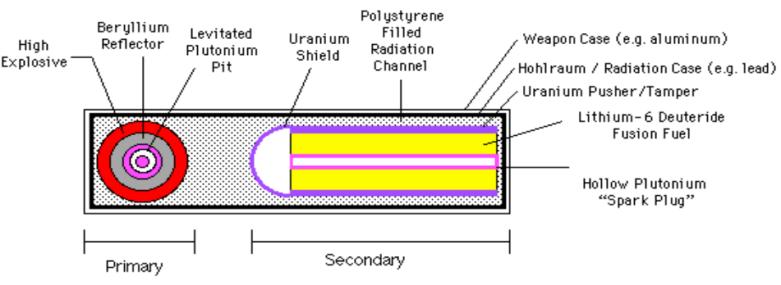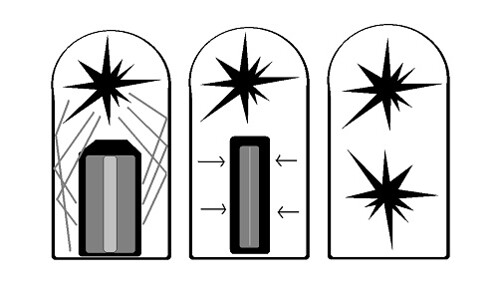The Infamous Teller-Ulam Report 1951 Restricted Data
Table Of Content

For the next decade, Teller would commit a significant amount of his time to the effort of trying to figure out how you could make such a thing actually work. Just prior to the conference, on May 8 at Enewetak atoll in the western Pacific, a test explosion named George had successfully used a fission bomb to ignite a small quantity of deuterium and tritium. It was immediately clear to all scientists concerned that these new ideas—achieving a high density in the thermonuclear fuel by compression using a fission primary—provided for the first time a firm basis for a fusion weapon.
Biographical Memoirs: Volume 90
The huge energy released by fission was used for compression and ignition of fusion fuel. Simply put, the fission explosion created a shock wave that compressed fusion fuel inside the fission envelope. Again, remember that the context of this is Ulam’s initial idea for very high efficiency fission bombs, not just hydrogen bombs. The rest explains that the goal here is very high compression of relatively large masses of material (fusion fuel). Enrico Fermi came up with the basic idea using the power of a fission bomb to ignite fusion reactions — a thermonuclear or hydrogen bomb — as early as 1941.

Basic Principles of Staged Radiation Implosion
The concept of a thermonuclear fusion bomb ignited by a smaller fission bomb was initially suggested by Enrico Fermi to Edward Teller in 1941during the inception of the Manhattan Project. [2] This idea caused Teller to spend most of his time during the Manhattan Project attempting to figure out how to make this concept work; neglecting his assigned work on the Manhattan Project. Teller, was able to convince his colleague Stanislaw Ulam, to join him on this idea provided by Fermi.
The United States Developments
The result of all this, though, was a report signed by Teller and Ulam titled “On Heterocatalytic Detonations I. Hydrodynamic Lenses and Radiation Mirrors,” report # LAMS-1225, dated March 9, 1951. We’ll get to the “heterocatalytic” in a moment, but the “hydrodynamic lenses” are the initial Ulam compression scheme; the “radiation mirrors” is related to Teller’s insights with regards to radiation implosion. This is in distinction to hitherto-considered autocatalytic schemes based essentially on self-implosions of a mixture of nuclear substances. That it took Teller — and everyone else at Los Alamos — a full ten years to figure out how to solve the problem is a good indication that it was a very hard problem.
The Jewish Designers of North Korea’s Hydrogen Bomb - Forward
The Jewish Designers of North Korea’s Hydrogen Bomb.
Posted: Thu, 14 Sep 2017 07:00:00 GMT [source]
The explosion achieved a yield of 10.4 megatons (million tons), 500 times larger than the Nagasaki bomb, and it produced a crater 1,900 metres (6,240 feet) in diameter and 50 metres (164 feet) deep. The largest thermonuclear bomb ever created and detonated was the Russian Tsar Bomba (bomb-emperor in Russian), tested in 1961 in remote areas of Novaya Zemlya. It detonated 4 km above ground and achieved a yield of 50 Mt. The shock wave from the blast travelled three times around the Earth. Thermal equilibrium is established extremely rapidly, so that the temperature and energy density is uniform throughout the radiation channel. As the surface of the tamper becomes heated, it expands and ablates (blows off the fuel capsule surface).
This led to a large radioactive contamination of the east part of the Bikini atoll. By an explosion of one or several conventional auxiliary fission bombs, one hopes to establish conditions for the explosion of a “principal” bomb. The force that compresses and accelerates the fusion fuel inward is provided solely by the ablation pressure. To make use of these fuels, the slower reaction rates must be offset by compressing them to densities hundreds or thousands of times greater than those of normal conditions. At any given temperature the reaction rate goes up with the square of the density, a thousand-fold compression gives a million-fold reaction rate increase. The bomb was the first full-scale test of the Teller-Ulam design, and its explosion completely destroyed the test island Elugelab, leaving a nearly 2 km wide crater where the island had once been.
Do You Want to Know a Secret? - The Bulwark
Do You Want to Know a Secret?.
Posted: Wed, 25 Jan 2023 08:00:00 GMT [source]
Responses to “The Infamous Teller-Ulam Report ( ”
The rod fissions at an accelerating rate as it, and the rest of the fuel capsule continue to implode and acts as the fusion "spark plug". Combined with the high temperatures generated by the convergent shock wave, this raises the temperature of the fusion fuel around the rod high enough to initiate the fusion reaction. The fusion tamper prevents the escape of thermal radiation from the fuel, enhancing the burn efficiency considerably. The temperatures generated by fusion burning can considerably exceed that produced by fission (up to 300 million K).
Thermonuclear bomb
The bomb casing is roughly cylindrical, with the fission Primary (or "trigger") at one end. The fusion fuel (lithium deuteride in the diagram) is a cylinder or ellipsoid wrapped in a pusher/tamper - a layer of very dense material (uranium or tungsten). Running down the axis of the fuel cylinder is a Pu-239 or U-235 rod, 2-3 cm or so in diameter.
Castle Bravo
Although there were attempts to use the great energy of thermonuclear explosions for peaceful uses like heating water in underground caverns, mining or hydraulic fracking for gas mining, it was never achieved. Further innovation in miniaturizing warheads continued through the mid-1970s, however, much of the Teller-Ulam design for these weapons and older are considered a top nuclear secret. Most information in the public domain about these designs is relegated to a few terse statements by the Department of Energy and the work of a few individual investigators.
Biographic Memoirs Volume 90 contains the biographies of deceased members of the National Academy of Sciences and bibliographies of their published works. Each biographical essay was written by a member of the Academy familiar with the professional career of the deceased. For historical and bibliographical purposes, these volumes are worth returning to time and again.
Separating the trigger from the fuel package is a thick plug of dense material (again U or W). Experiments with particle accelerators proved the possibility of fusion reactions, but the first large fusion energy release was realised in a thermonuclear bomb. The hydrogen bomb can be considered the first successful demonstration of inertial confinement.
The 2.45 MeV and 14.1 MeV neutrons that escape from the fusion fuel can also contribute greatly to bomb yield by inducing fission in the highly compressed fusion tamper. This extra boost can release most of the explosion energy, and commonly accounts for half of the yield of large fission-fusion-fission bombs and can reach at least 85% of the total yield. When the primary explodes, the X-rays escaping from the fission trigger fill the radiation channel, the space between the bomb casing and the fusion capsule, with a photon gas. This space is filled with plastic foam, essentially just carbon and hydrogen, which becomes completely ionized and transparent as the x-rays penetrate. The inner casing and outer capsule surfaces are heated to very high temperatures. The uranium shield between the trigger and the fusion capsule, and capsule pusher/tamper, prevents the fusion fuel from becoming heated prematurely.
The first device used to demonstrate the hydrogen bomb principle was the Greenhouse Item, detonated in 1951 on the island of the Pacific atoll Enewetak. It was not a true fission bomb and was never intended to be a weapon, but it demonstrated that the direction of thermonuclear bomb research was correct. The deuterium-tritium gas was inserted into the enriched-uranium core of the fission bomb. The neutrons generated from fusion helped to burn fissile fuel and nearly double the yield of a fission bomb. Work on the hydrogen bomb was carried out together with the fission bomb development.
At the very least, it required a familiarity with nuclear reactions at energy regimes which had never been achieved previously on Earth. It also required breaking out of several wrong ideas along the way whose wrongness was not obvious. Since the D+T reaction rate is so high, and there is large excess of deuterium, the tritium is consumed almost as fast it is produced. The 14.1 MeV neutrons also produce large amounts of tritium from Li-7 through reaction 6.
This ablation process, essentially a rocket turned inside out, generates tremendous pressure on the fuel capsule and causes an accelerating implosion. Thermal equilibrium assures that the implosion pressure is very uniformly distributed. The transparent carbon-hydrogen plasma retards the early expansion of the tamper and casing plasmas, keeping the radiation channel from being blocked by these opaque high-Z materials until equilibrium is fully established. The first transportable US bomb was Castle Bravo, which used lithium deuteride, which is solid at room temperature. Its yield was 2.5 times greater than predicted because of unforeseen additional reactions involving lithium 7.
The fuel in the fission capsule consists of lithium deuteride that may be enriched in the Li-6 isotope (which makes up 7.5% of natural lithium). There is some tritium generated by the fission neutrons, but as noted above the contribution to bomb yield is insignificant. Far more tritium is produced by the D+D reactions, either directly by reaction 3, or by reaction 5 via the neutrons produced in reaction 2. The principles of the Teller-Ulam configuration are more easily explained with the help of the diagram below.
Comments
Post a Comment